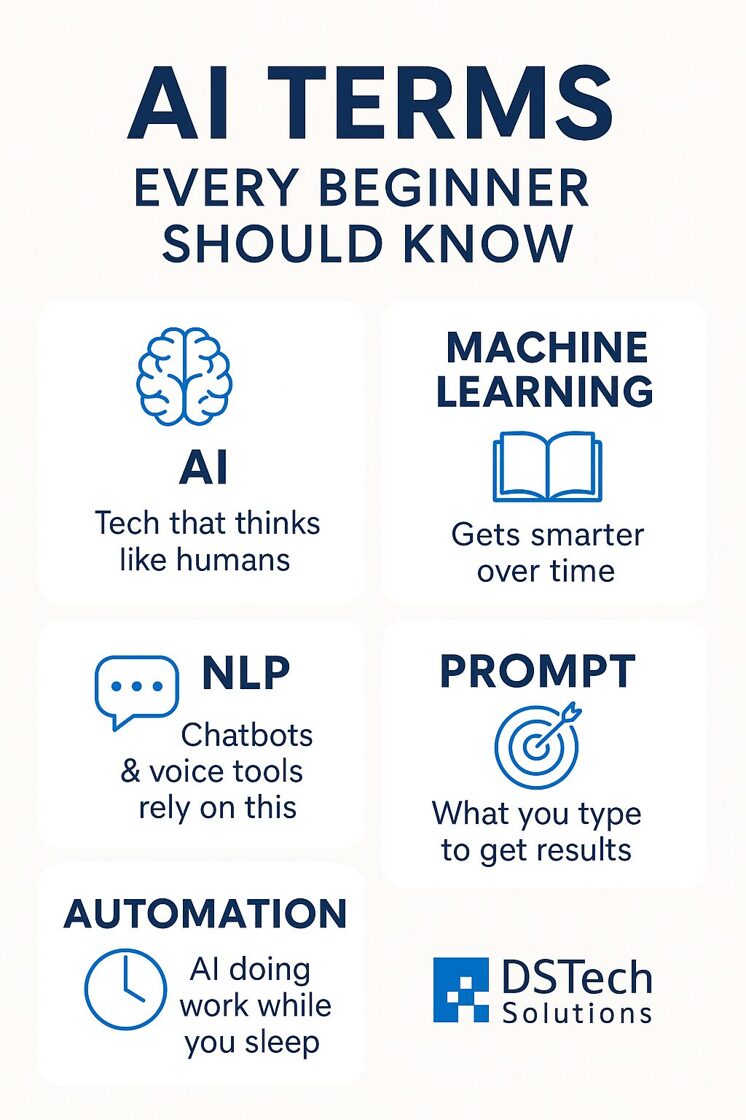Common AI Terms Defined: A Beginner’s Glossary
DSTech Solutions | Making AI Practical for Small Business

Artificial Intelligence can sound like a foreign language if you’re just getting started. At DSTech Solutions, we believe in making AI practical and approachable—so we’ve compiled this simple glossary of common AI terms. Whether you’re a small business owner, office manager, or practice administrator, this guide will help you feel more confident as you explore AI tools.
🤖 Artificial Intelligence (AI)
Definition: The broad field of creating machines that mimic human intelligence—like learning, reasoning, and problem-solving.
Think of it as: The umbrella that covers everything from chatbots to self-driving cars.
🧠 Machine Learning (ML)
Definition: A subset of AI that enables machines to learn from data and improve over time without being explicitly programmed.
Example: Email filters that learn to recognize spam based on what you mark as junk.
📊 Algorithms
Definition: A set of step-by-step instructions or rules used by AI to make decisions or solve problems.
Real-world analogy: A recipe in a cookbook—but for data.
📚 Training Data
Definition: The information or examples given to an AI so it can learn patterns and make predictions.
Example: Feeding thousands of images of invoices to an AI to help it learn to recognize and extract payment information.
💬 Natural Language Processing (NLP)
Definition: The branch of AI that allows machines to understand and respond to human language.
Used in: Chatbots, voice assistants, AI writing tools.
🧠 Neural Networks
Definition: Computer systems inspired by the human brain that help AI detect complex patterns in data.
You’ve seen it in: Image recognition, facial detection, and advanced fraud alerts.
🎯 Prompt
Definition: A piece of text or instruction given to an AI (like ChatGPT) to produce a response.
Tip: Clear, specific prompts get better results—like giving good directions to a helpful assistant.
📦 Model
Definition: The trained system that produces AI output based on data and algorithms.
Think of it as: The "brain" that’s been trained and is now ready to work.
🧪 Fine-Tuning
Definition: Customizing an AI model with your specific data to make it more accurate or relevant to your needs.
Great for: Tailoring an AI chatbot to understand your business’s tone or procedures.
⏱️ Automation
Definition: Using AI or software to perform repetitive tasks without human input.
Common examples: Auto-scheduling social media, summarizing emails, generating reports.
Final Thoughts
You don’t need to become a data scientist to benefit from AI—but knowing the language makes it easier to navigate this space. At DSTech Solutions, we help small businesses like yours implement real-world AI solutions that save time and improve operations.
If you're ready to explore how AI can work for your team, contact us today—we speak both tech and plain English.
Please take a moment to Comment. Your questions are greatly appreciated!
- thanks, Sam
Transforming business operations with smarter technology.
